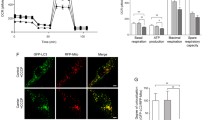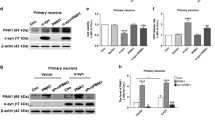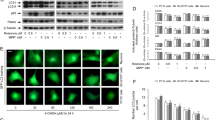Abstract
The etiology of Parkinson’s disease (PD) remains unknown. Mutations in several genes, including PINK1, have provided an understanding of the molecular mechanisms of this pathology. We analyzed the role of PINK1 overexpression (wild-type PINK1 or PINK1 with G309D or L347P mutations) on neurotoxicity associated with C2-ceramide exposure in CAD cells. CAD cells were transiently transfected with either PINK1 (wild type or mutated) or with empty vector and then treated with 25-μM C2-ceramide for 6 h. Cell viability and mitochondrial membrane potential were analyzed by flow cytometry, expression of Bax and Bcl-2 was determined by real-time PCR, and AKT phosphorylation was analyzed by western blot. CAD cells overexpressing wild-type PINK1 and treated with C2-ceramide showed lower percentages of depolarized mitochondria, lower expressions of Bax and higher expressions of Bcl-2 than non-transfected cells. In addition, wild-type PINK1 rescued C2-ceramide-induced inhibition of AKT phosphorylation. Overexpression of PINK1 G309D mutation caused an increase of depolarized mitochondria, a decrease of Bax and an increase in Bcl-2 expression levels. PINK1 L4347P mutation was associated with a higher drop in mitochondrial membrane potential and increased expression of Bax, with minimal variation in the expression of Bcl-2. PINK1 mutations did not result in variations of AKT phosphorylation. We suggest that by preventing mitochondrial dysfunction and reinforcing anti-apoptotic and neuronal survival pathways such as Bcl-2 and PI3K/AKT, PINK1 confers a neuroprotective effect against the neurotoxin C2-ceramide. These effects were abrogated by PINK1 mutations.






Similar content being viewed by others
References
Adams JM, Cory S (1998) The Bcl-2 protein family: arbiters of cell survival. Science 281:1322–1326
Arboleda G, Waters C, Gibson RM (2005) Metabolic activity: a novel indicator of neuronal survival in the murine dopaminergic cell line CAD. J Mol Neurosci 27:65–77
Arboleda G, Morales LC, Benitez B, Arboleda H (2009) Regulation of ceramide-induced neuronal death: cell metabolism meets neurodegeneration. Brain Res Rev 59:333–346
Beilina A, Van Der BM, Ahmad R et al (2005) Mutations in PTEN-induced putative kinase 1 associated with recessive parkinsonism have differential effects on protein stability. Proc Natl Acad Sci USA 102:5703–5708
bou-Sleiman PM, Muqit MM, McDonald NQ et al (2006) A heterozygous effect for PINK1 mutations in Parkinson’s disease? Ann Neurol 60:414–419
Bras J, Singleton A, Cookson MR, Hardy J (2008) Emerging pathways in genetic Parkinson’s disease: potential role of ceramide metabolism in Lewy body disease 1. FEBS J 275:5767–5773
Cookson MR (2010) The role of leucine-rich repeat kinase 2 (LRRK2) in Parkinson’s disease. Nat Rev Neurosci 11:791–797
Cookson MR, Xiromerisiou G, Singleton A (2005) How genetics research in Parkinson’s disease is enhancing understanding of the common idiopathic forms of the disease. Curr Opin Neurol 18:706–711
Cutler RG, Kelly J, Storie K et al (2004) Involvement of oxidative stress-induced abnormalities in ceramide and cholesterol metabolism in brain aging and Alzheimer’s disease. Proc Natl Acad Sci USA 101:2070–2075
da Costa CA, Ancolio K, Checler F (2000) Wild-type but not Parkinson’s disease-related ala-53 – > Thr mutant alpha-synuclein protects neuronal cells from apoptotic stimuli. J Biol Chem 275:24065–24069
Dagda RK, Cherra SJ III et al (2009) Loss of PINK1 function promotes mitophagy through effects on oxidative stress and mitochondrial fission. J Biol Chem 284:13843–13855
Darios F, Corti O, Lucking CB et al (2003) Parkin prevents mitochondrial swelling and cytochrome c release in mitochondria-dependent cell death. Hum Mol Genet 12:517–526
Deng H, Jankovic J, Guo Y, Xie W, Le W (2005) Small interfering RNA targeting the PINK1 induces apoptosis in dopaminergic cells SH-SY5Y. Biochem Biophys Res Commun 337:1133–1138
Dorsey ER, Constantinescu R, Thompson JP, Biglan KM, Holloway RG, Kieburtz K, Marshall FJ, Ravina BM, Schifitto G, Siderowf A, Tanner CM (2007) Projected number of people with Parkinson disease in the most populous nations, 2005 through 2030. Neurology 68:384–386
Exner N, Treske B, Paquet D et al (2007) Loss-of-function of human PINK1 results in mitochondrial pathology and can be rescued by parkin. J Neurosci 27:12413–12418
France-Lanord V, Brugg B, Michel PP, Agid Y, Ruberg M (1997) Mitochondrial free radical signal in ceramide-dependent apoptosis: a putative mechanism for neuronal death in Parkinson’s disease. J Neurochem 69:1612–1621
Sambrook J, Fritsch EF, Maniatis T (2003) Molecular cloning: a laboratory manual. Cold Spring Harbor Laboratory Press, NY, Vol. 1, 2, 3. Protocol 6, 1.51.Ref Type: Book Chapter
Funayama M, Hattori N (2007) [Molecular genetics of PINK1]1107. Brain Nerve 59:831–838
Gandhi S, Wood-Kaczmar A, Yao Z et al (2009) PINK1-associated Parkinson’s disease is caused by neuronal vulnerability to calcium-induced cell death. Mol Cell 33:627–638
Ganesan V, Perera MN, Colombini D, Datskovskiy D, Chadha K, Colombini M (2010) Ceramide and activated Bax act synergistically to permeabilize the mitochondrial outer membrane. Apoptosis 15:553–562
Gautier CA, Kitada T, Shen J (2008) Loss of PINK1 causes mitochondrial functional defects and increased sensitivity to oxidative stress. Proc Natl Acad Sci USA 105:11364–11369
Gelb DJ, Oliver E, Gilman S (1999) Diagnostic criteria for Parkinson disease. Arch Neurol 56:33–39
Ha KS, Kim KM, Kwon YG et al (2003) Nitric oxide prevents 6-hydroxydopamine-induced apoptosis in PC12 cells through cGMP-dependent PI3 kinase/AKT activation. FASEB J 17:1036–1047
Haque ME, Thomas KJ, D’Souza C et al (2008) Cytoplasmic PINK1 activity protects neurons from dopaminergic neurotoxin MPTP. Proc Natl Acad Sci USA 105:1716–1721
Hashimoto M, Bar-On P, Ho G (2004) Beta-synuclein regulates AKT activity in neuronal cells. A possible mechanism for neuroprotection in Parkinson’s disease. J Biol Chem 279:23622–23629
Hay N (2005) The AKT–mTOR tango and its relevance to cancer. Cancer Cell 8:179–183
Healy DG, bou-Sleiman PM, Casas JP et al (2006) UCHL-1 is not a Parkinson’s disease susceptibility gene. Ann Neurol 59:627–633
Hirsch E, Costa C, Ciraolo E (2007) Phosphoinositide 3-kinases as a common platform for multi-hormone signaling. J Endocrinol 194:243–256
Jana A, Hogan EL, Pahan K (2009) Ceramide and neurodegeneration: susceptibility of neurons and oligodendrocytes to cell damage and death. J Neurol Sci 278:5–15
Kihara T, Shimohama S, Sawada H et al (2002) Protective effect of dopamine D2 agonists in cortical neurons via the phosphatidylinositol 3 kinase cascade. J Neurosci Res 70:274–282
Kim SJ, Winter K, Nian C, Tsuneoka M, Koda Y, McIntosh CH (2005) Glucose-dependent insulinotropic polypeptide (GIP) stimulation of pancreatic beta-cell survival is dependent upon phosphatidylinositol 3-kinase (PI3K)/protein kinase B (PKB) signaling, inactivation of the forkhead transcription factor Foxo1, and down-regulation of Bax expression. J Biol Chem 280:22297–22307
Kitada T, Asakawa S, Hattori N et al (1998) Mutations in the parkin gene cause autosomal recessive juvenile parkinsonism. Nature 392:605–608
Maj MC, Tkachyova I, Patel P et al (2010) Oxidative stress alters the regulatory control of p66Shc and AKT in PINK1 deficient cells. Biochem Biophys Res Commun 399:331–335
Mills RD, Sim CH, Mok SS, Mulhern TD, Culvenor JG, Cheng HC (2008) Biochemical aspects of the neuroprotective mechanism of PTEN-induced kinase-1 (PINK1). J Neurochem 105:18–33
Moriwaki Y, Kim YJ, Ido Y et al (2008) L347P PINK1 mutant that fails to bind to Hsp90/Cdc37 chaperones is rapidly degraded in a proteasome-dependent manner. Neurosci Res 61:43–48
Murata H, Sakaguchi M, Jin Y et al (2010) A new cytosolic pathway from a Parkinson’s disease-associated kinase, BRPK/PINK1: activation of AKT via MTORC2. J. Biol, Chem
Nakagomi S, Suzuki Y, Namikawa K, Kiryu-Seo S, Kiyama H (2003) Expression of the activating transcription factor 3 prevents c-Jun N-terminal kinase-induced neuronal death by promoting heat shock protein 27 expression and AKT activation. J Neurosci 23:5187–5196
Petit A, Kawarai T, Paitel E et al (2005) Wild-type PINK1 prevents basal and induced neuronal apoptosis, a protective effect abrogated by Parkinson disease-related mutations. J Biol Chem 280:34025–34032
Pfaffl MW (2001) A new mathematical model for relative quantification in real-time RT-PCR. Nucleic Acids Res 29:e45
Plun-Favreau H, Klupsch K, Moisoi N et al (2007) The mitochondrial protease HtrA2 is regulated by Parkinson’s disease-associated kinase PINK1. Nat Cell Biol 9:1243–1252
Pridgeon JW, Olzmann JA, Chin LS, Li L (2007) PINK1 protects against oxidative stress by phosphorylating mitochondrial chaperone TRAP1. PLoS Biol 5:e172
Qi Y, Wang JK, McMillian M, Chikaraishi DM (1997) Characterization of a CNS cell line, CAD, in which morphological differentiation is initiated by serum deprivation 1106. J Neurosci 17:1217–1225
Rogaeva E, Johnson J, Lang AE et al (2004) Analysis of the PINK1 gene in a large cohort of cases with Parkinson disease. Arch Neurol 61:1898–1904
Rolland SG, Conradt B (2010) New role of the BCL2 family of proteins in the regulation of mitochondrial dynamics. Curr Opin Cell Biol 22:852–858
Sarbassov DD, Guertin DA, Ali SM, Sabatini DM (2005) Phosphorylation and regulation of AKT/PKB by the rictor-mTOR complex 3. Science 307:1098–1101
Sato S, Fujita N, Tsuruo T (2000) Modulation of AKT kinase activity by binding to Hsp90. Proc Natl Acad Sci USA 97:10832–10837
Shan Y, Liu B, Li L et al (2009) Regulation of PINK1 by NR2B-containing NMDA receptors in ischemic neuronal injury. J Neurochem 111:1149–1160
Shimoke K, Chiba H (2001) Nerve growth factor prevents 1-methyl-4-phenyl-1,2,3,6-tetrahydropyridine-induced cell death via the AKT pathway by suppressing caspase-3-like activity using PC12 cells: relevance to therapeutical application for Parkinson’s disease. J Neurosci Res 63:402–409
Silvestri L, Caputo V, Bellacchio E et al (2005) Mitochondrial import and enzymatic activity of PINK1 mutants associated to recessive parkinsonism. Hum Mol Genet 14:3477–3492
Sim CH, Lio DS, Mok SS et al (2006) C-terminal truncation and Parkinson’s disease-associated mutations down-regulate the protein serine/threonine kinase activity of PTEN-induced kinase-1. Hum Mol Genet 15:3251–3262
Singleton AB, Farrer M, Johnson J et al (2003) Alpha-synuclein locus triplication causes Parkinson’s disease. Science 302:841
Siskind LJ, Mullen TD, Romero RK et al (2010) The BCL-2 protein BAK is required for long-chain ceramide generation during apoptosis. J Biol Chem 285:11818–11826
Valente EM, bou-Sleiman PM, Caputo V et al (2004) Hereditary early-onset Parkinson’s disease caused by mutations in PINK1. Science 304:1158–1160
Vives-Bauza C, de Vries RL, Tocilescu M, Przedborski S (2010) PINK1/parkin direct mitochondria to autophagy. Autophagy 6:315–316
Wang HL, Chou AH, Yeh TH et al (2007) PINK1 mutants associated with recessive Parkinson’s disease are defective in inhibiting mitochondrial release of cytochrome c. Neurobiol Dis 28:216–226
Weihofen A, Ostaszewski B, Minami Y, Selkoe DJ (2008) PINK1 Parkinson mutations, the Cdc37/Hsp90 chaperones and Parkin all influence the maturation or subcellular distribution of PINK1. Hum Mol Genet 17:602–616
Wirdefeldt K, Adami HO, Cole P, Trichopoulos D, Mandel J (2011) Epidemiology and etiology of Parkinson’s disease: a review of the evidence. Eur J Epidemiol 26(Suppl 1):S1–58
Wood-Kaczmar A, Gandhi S, Yao Z, Abramov AY et al (2008) PINK1 is necessary for long term survival and mitochondrial function in human dopaminergic neurons. PLoS One 3:e2455
Yamaguchi H, Wang HG (2001) The protein kinase PKB/AKT regulates cell survival and apoptosis by inhibiting Bax conformational change. Oncogene 20:7779–7786
Zhou L, Chang DC (2008) Dynamics and structure of the Bax-Bak complex responsible for releasing mitochondrial proteins during apoptosis. J Cell Sci 121:2186–2196
Acknowledgements
PINK1 constructs were a kind gift from Dr. Mark Cookson (NIH, USA). CAD cells were a kind gift from Dr. Dona M. Chikaraishi, Department of Neurobiology, Duke University Medical Center, Durham, NC, USA. This work was supported by grants from COLCIENCIAS (110145221189), DIB-Universidad Nacional de Colombia (20101007590, 20201009689) and the Facultad de Medicina, Universidad Nacional de Colombia.
Author information
Authors and Affiliations
Corresponding author
Rights and permissions
About this article
Cite this article
Sánchez-Mora, R.M., Arboleda, H. & Arboleda, G. PINK1 Overexpression Protects Against C2-ceramide-Induced CAD Cell Death Through the PI3K/AKT Pathway. J Mol Neurosci 47, 582–594 (2012). https://doi.org/10.1007/s12031-011-9687-z
Received:
Accepted:
Published:
Issue Date:
DOI: https://doi.org/10.1007/s12031-011-9687-z




